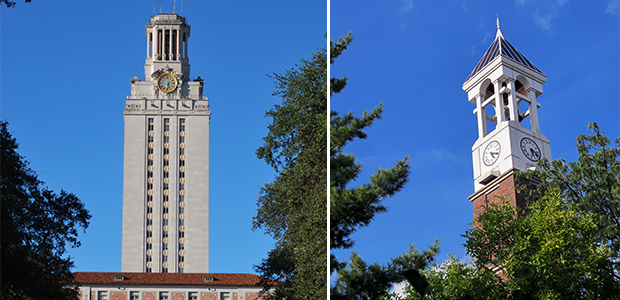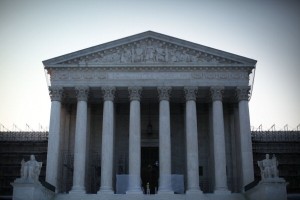What You Need To Know About Affirmative Action, College Admissions & Wednesday's Supreme Court Hearing

UT Photo by Mira Oberman / AFP / Getty Images // Purdue Photo by Kyle Stokes / StateImpact Indiana
The Main Building or "UT Tower" at the University of Texas at Austin (left) and the Purdue Bell Tower in West Lafayette. An affirmative action lawsuit involving a University of Texas lawsuit could have a ripple effect throughout higher education.
The U.S. Supreme Court will hear oral arguments Wednesday in a case that could decide what, if any, continuing role affirmative action will play in deciding which students get admitted to colleges and universities.
The case, Fisher v. University of Texas at Austin, revolves around Abigail Fisher, 22, a white student who who claims she was denied admission to the University of Texas because of her race.
The potential impacts on higher education are massive. If the Supreme Court changes the stance it’s taken as recently as 2003 in affirmative action cases, one IU education professor predicts “universities throughout the U.S. will need to adjust their admissions policies, and the number of minority students at some universities will likely decrease.”
More on Fisher from The Answer Sheet:
Fisher, from Sugar Land, Texas, enrolled in Louisiana State University and graduated in the spring with a finance degree. She wants the Supreme Court to rule that it was and shall be illegal for the University of Texas-Austin to include race in admissions decisions, a decision that would affect other schools as well.
The university automatically admits the top 10 percent of students from every Texas high school, though she was not in that group in her school. She and her supporters argue that the 10 percent rule assures a diverse group and that race shouldn’t be a consideration for decisions made about students beyond those who automatically are accepted.
Race is a factor when University of Texas admissions officials consider students who aren’t in the top 10 percent of their high school class. But UT officials categorically deny the claim that Fisher was denied admission because she was white, reports NPR justice correspondent Nina Totenberg, who adds helps put the case in a national context:
Over the past 35 years, the court has twice ruled that race may be one of many factors in determining college admissions, as long as there are no racial quotas. Now, just nine years after its last decision, the justices seem poised to outright reverse or cut back on the previous rulings.
This time, the question is whether any sort of affirmative action program can be adopted on top of a race-neutral system that has produced at least some significant increase in campus diversity.
Interest in the case is high. The Brookings Institution points out SCOTUS has received more than 90 amicus briefs — in which outside groups file an argument with the High Court — in the Fisher case, “one of the highest totals for any Supreme Court case in history.”
As a point-counterpoint in The Chronicle of Higher Education highlights, the issue of race remains sensitive. Aaron Taylor writes blacks remain at tremendous socio-economic disadvantages when compared to whites, and affirmative action is one way to create equality of opportunity.
But Richard Kahlenberg argues the issue Taylor sees in play is poverty, not race:
Some critics worry that if the Supreme Court strikes down race-based affirmative action today, it will strike down race-neutral alternatives tomorrow. In fact, socioeconomic classifications are subject to a far different level of judicial review than racial classifications. Indeed, the most conservative U.S. Supreme Court justices, Antonin Scalia and Clarence Thomas, have explicitly endorsed class-based affirmative-action programs.
Totenberg says, whatever the merits of their arguments, affirmative action supporters have an uphill fight with the Roberts court:
In 2003, when the court upheld limited affirmative action programs, the 5-to-4 decision was written by Justice Sandra Day O’Connor. She has since retired and been replaced by Justice Samuel Alito, a dedicated foe of affirmative action. That leaves Justice Anthony Kennedy as the decisive vote in this case. While in the past he has accepted the need for diversity in college admissions, he has never seen a program that he thought met constitutional muster.
Justice Elena Kagan is recused, presumably because she worked on this case when she was in the Obama administration. Thus, the best that affirmative action supporters can hope for is a 4-4 tie, which would preserve the status quo. Most experts, though, think that a tie is very unlikely and that the court accepted this case for the very purpose of either reversing its past affirmative action rulings, or making such plans so restrictive that they are possible in theory, but not in practice.


